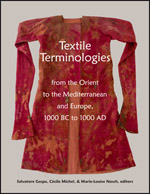Centre for Textile Research
Date of this Version
2017
Document Type
Article
Citation
In Textile Terminologies from the Orient to the Mediterranean and Europe, 1000 BC to 1000 AD, ed. Salvatore Gaspa, Cécile Michel, & Marie-Louise Nosch (Lincoln, NE: Zea Books, 2017), pp. 107-121.
doi:10.13014/K20863GM
Abstract
The investigation of textiles and clothes in ancient Mesopotamia has been anything but neglected in Assyriological studies. For the Neo- and Late Babylonian periods, in particular, two fundamental monographs have shed light on the clothes worn by the deities worshiped in lower Mesopotamia. 2 Scholars, however, have focused almost exclusively on clothing in the cultic context. This is due to a prevalence of textual sources – mostly economic or administrative documents – recording clothing items worn by divine images during festivals and rituals. Sources on the clothes worn by common people, instead, are close to non-existent. Still, we cannot overlook the fact that Mesopotamian towns were crowded by people rather than by gods. These people were workers, slaves and soldiers, and each one of them – man or woman – wore clothes in his or her everyday life. The objective of the present paper is to examine the three main clothing items worn by common people, using textual sources of the Neo- and Late Babylonian periods. These items were túg-kurra (a blanket of a sort used as garment), muṣiptu (a generic garment), and šir’am (a jerkin).
Methodology -- Two essays in the book Textile Terminologies in the Ancient Near East and Mediterranean from the Third to the First Millennia BC (2010) focus on textiles and clothing in the Neo-Babylonian period.3 In his article, Stefan Zawadzki investigates clothing in non-cultic contexts. As a guideline for the study of non-cultic attire, I list below the different types of documents singled out by Zawadzki as being most likely to include references to clothing items not destined for the statues of gods.4 • dowries; • quittances for rations; • payments for wet nurses; • text concerning military uniforms; • texts concerning workmen’s clothes. My focus and Zawadzki’s, however, are different. Zawadzki, in his article, deals with clothing in non-cultic contexts, whereas here I discuss clothing for common people. The non-divine clothing items mentioned in text usually belong to the fine apparel of the privileged classes of Mesopotamian society. These fall outside of the scope of the present study, which concentrates exclusively on inexpensive clothing items worn by the middle-low classes in Babylon. But who exactly were these ‘common people’? Neo- and Late Babylonian society was roughly divided into two classes. The first was that of the mār banê, the free citizens, while the second gathered individuals legally depending from the central administration (the temple or the palace) or in a condition of slavery. The mār banê enjoyed full rights in front of the law and could own one or more slaves. They included temple officials, merchants, bankers, craftsmen, farmers, and also individuals living in poverty.5 The second class, instead, included both free individuals deprived of civil rights, such as the ‘royal soldier’ (bēl qašti), the ‘partially free dependents’ (šušānū),6 and totally unfree individuals such as the slaves (ardū or qallū) or the servants of the temple (širkū). Evidently, when we speak of common people we are mainly referring to people belonging to this second class, although we cannot overlook the mār banê class, insofar as it also included non-wealthy individuals. To sum up, by ‘common people’ I mean here all the members of Babylonian society, whether free or not, who did not hold prestigious positions, such as dependent workers (workmen, craftsmen, etc.), apprentices, or slaves.
Included in
Ancient History, Greek and Roman through Late Antiquity Commons, Art and Materials Conservation Commons, Classical Archaeology and Art History Commons, Classical Literature and Philology Commons, Fiber, Textile, and Weaving Arts Commons, Indo-European Linguistics and Philology Commons, Jewish Studies Commons, Museum Studies Commons, Near Eastern Languages and Societies Commons, Other History of Art, Architecture, and Archaeology Commons


Comments
Copyright © 2017 Salvatore Gaspa, Cécile Michel, & Marie-Louise Nosch. Photographs copyright as noted.